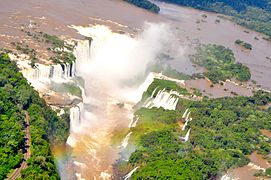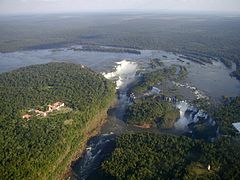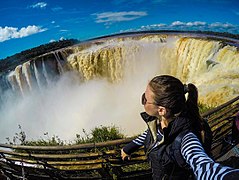
One of the modern natural wonders of the world, this chain of mini waterfalls is one of the planet's most awe-inspiring sights. A visit is an awe-inspiring visceral experience, and the power and noise of the cascades – a chain of hundreds of waterfalls nearly 3km in extension – is something you won't forget. The falls lie split between Brazil and Argentina in a large expanse of national park, much of it rainforest teeming with unique flora and fauna.On the Argentine side of the marvelous falls, this park has loads to offer, and involves a fair amount of walking. The spread-out entrance complex ends at a train station, with departures every half-hour to the Cataratas train station, where the waterfall walks begin, and to the Garganta del Diablo. You may prefer to walk: it’s only 650m along the Sendero Verde path to the Cataratas station, and a further 2.3km to the Garganta. You may well see capuchin monkeys along the way.
Iguazú Falls or Iguaçu Falls (Spanish: Cataratas del Iguazú [kataˈɾatas ðel iɣwaˈsu]; Guarani: Chororo Yguasu [ɕoɾoɾo ɨɣʷasu]; Portuguese: Cataratas do Iguaçu [kataˈɾatɐs du iɡwaˈsu]) are waterfalls of the Iguazu Riveron the border of the Argentine province of Misiones and the Brazilian state of Paraná. Together, they make up the largest waterfall in the world.[2] The falls divide the river into the upper and lower Iguazu. The Iguazu River rises near the heart of the city of Curitiba. For most of its course, the river flows through Brazil; however, most of the falls are on the Argentine side. Below its confluence with the San Antonio River, the Iguazu River forms the boundary between Argentina and Brazil.
The name "Iguazú" comes from the Guarani or Tupi words "y" [ɨ], meaning "water", and "ûasú "[waˈsu], meaning "big".[3] Legend has it that a deity planned to marry a beautiful woman named Naipí, who fled with her mortal lover Tarobá in a canoe. In a rage, the deity sliced the river, creating the waterfalls and condemning the lovers to an eternal fall.[3]The first European to record the existence of the falls was the Spanish Conquistador Álvar Núñez Cabeza de Vaca in 1541.
TourismEdit
Two international airports are close to Iguazú Falls: the Argentine Cataratas del Iguazú International Airport (IGR) and the Brazilian Foz do Iguaçu International Airport (IGU). Bus and taxi services are available from and to the Airport-Falls. Aerolíneas Argentinas and LATAM Argentina[5] have direct flights from Buenos Aires to Iguazu International Airport Krause. Azul, GOL, and LATAM Brasil[6] offer services from main Brazilian cities to Foz do Iguaçu.GalleryEdit

Aerial view of the Iguazu Falls from a helicopter

Iguazu Falls from the Argentine side

Iguazu Falls from the Brazilian side

Aerial view, from the Argentine side

Bosetti waterfall

Falls and Brazilian tourist complex

Devil's Throat. View from Iguazu National Park, Argentina.

Devil's Throat. View from Iguazu National Park, Argentina.

Comparisons to other notable fallsEdit
See also: List of waterfalls by flow rate and Victoria Falls § Statistics
Upon seeing Iguazu, the United States First Lady Eleanor Roosevelt reportedly exclaimed, "Poor Niagara!"[3] (which, at 50 m or 165 feet, are a third shorter). Often, Iguazu also is compared with Victoria Falls in Southern Africa, which separates Zambia and Zimbabwe. Iguazu is wider, but because it is split into roughly 275 distinct falls and large islands, Victoria has the largest curtain of water in the world, at more than 1,600 m (5,249 ft) wide and over 100 m (328 ft) in height (in low flow, Victoria is split into five by islands; in high flow it may be uninterrupted). The only wider falls are extremely large rapid-like falls, such as the Boyoma Falls (Stanley Falls).
With the flooding of the Guaíra Falls in 1982, Iguazu currently has the sixth-greatest average annual flow of any waterfall in the world, following number five Niagara, with an average rate of 1,746 m3/s (61,660 cu ft/s). Its maximum recorded flow was 45,700 m3/s (1,614,000 cu ft/s) in 9 June 2014.[10][11] By comparison, the average flow of Niagara Falls is 2,400 m3/s (85,000 cu ft/s), with a maximum recorded flow of 8,300 m3/s (293,000 cu ft/s).[12] The average flow at Victoria Falls is 1,088 m3/s (38,420 cu ft/s), with a maximum recorded flow of 7,100 m3/s (250,000 cu ft/s).[13]
Comments
Post a Comment